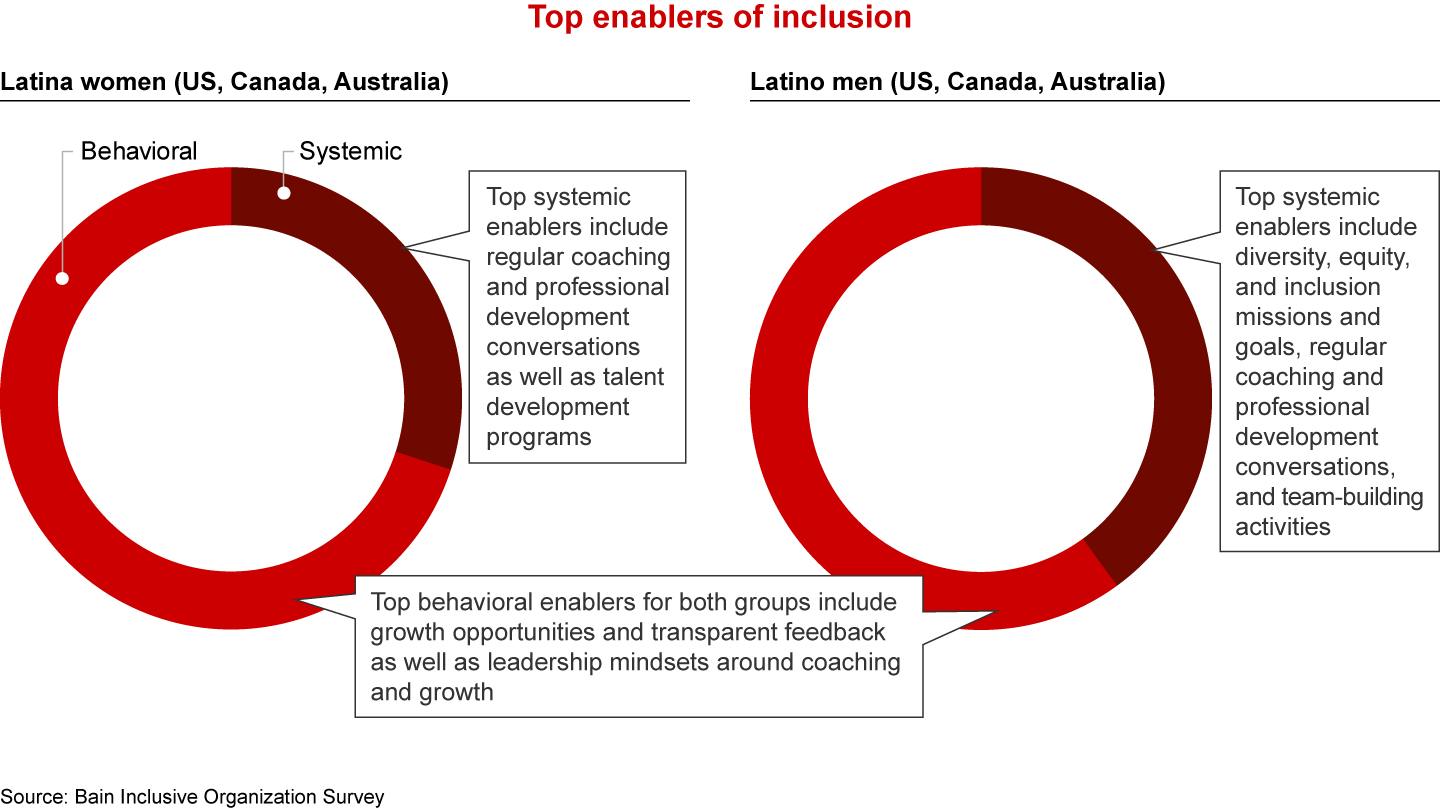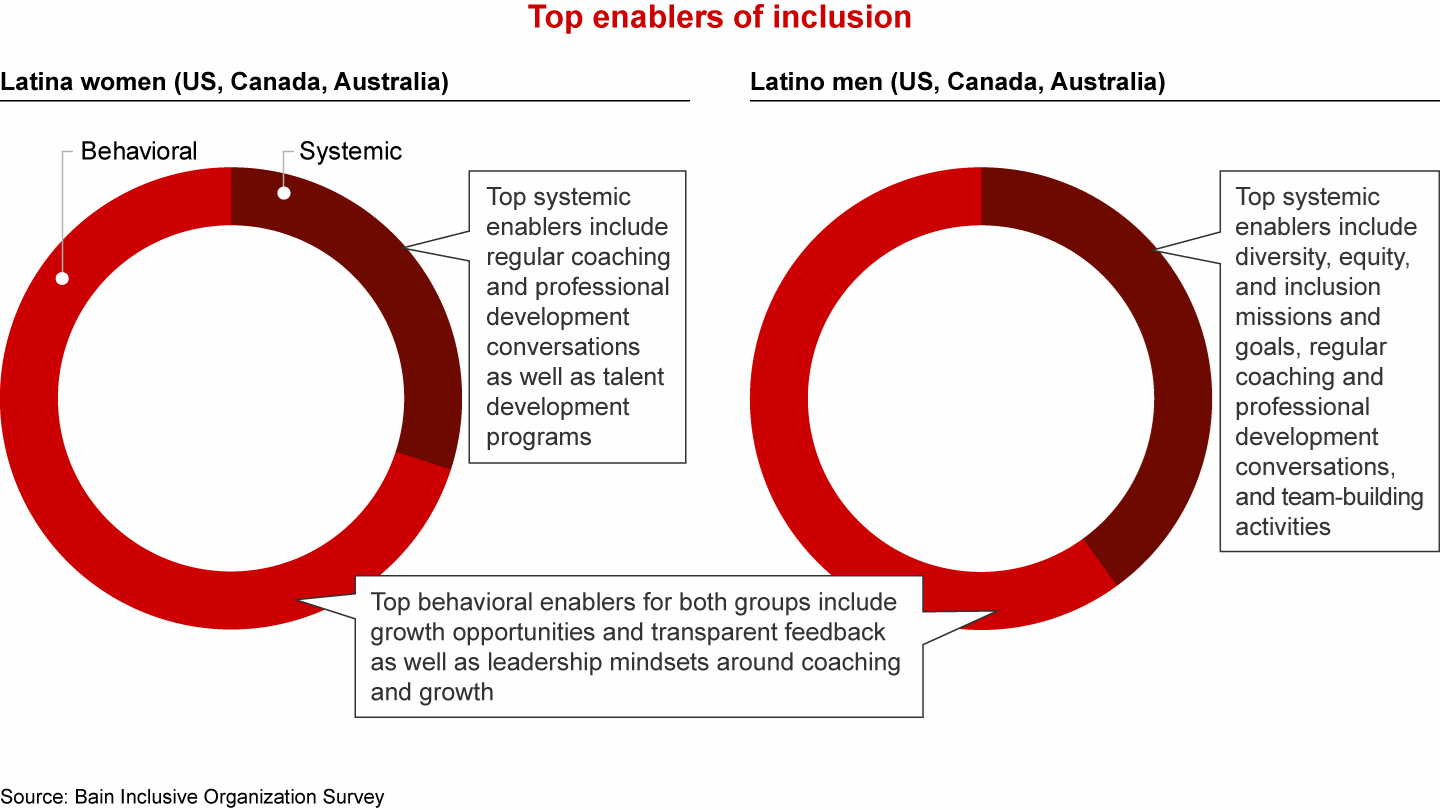Brief

The Latino community in the US is large and growing fast. Latinos comprised around 20% of the US population in 2019, a figure that is projected to grow by 29% by 2030. And Latinos participate in the labor market at higher-than-average rates—indeed, they accounted for about 80% of workforce growth from 2010 to 2017, and they are expected to represent nearly one in three working-age Americans by 2050.
Despite their substantial presence in the US labor force, however, Latino employees are not feeling included at work today. As Bain research described in our firm’s article “The Fabric of Belonging” has shown, only about 25% of Latinos say they feel fully included at their workplaces.
Given the ongoing war for talent, this is a big problem. It’s not just that making employees feel included is the right thing to do. Having employees feel fully included stimulates better individual and team performance; it also leads to better outcomes with recruitment and retention. Indeed, Latino workers who do not feel particularly included are around two times more likely to quit than are those who feel fully included, and nearly 45% of Latino workers who don’t feel completely included are actively seeking new jobs (compared with only around 25% of those who do feel fully included), according to Bain’s Inclusive Organization Survey. Meanwhile, around 70% of Latino workers indicate that inclusion is highly important for them in evaluating a prospective employer.
Enabling greater inclusion for Latino employees is therefore a clear win. So what can your company do to make your Latino workforce feel more included—and not just during Hispanic Heritage (also called Latinx Heritage) month but all the time?
There is no single answer. The Latino population in the US is hugely diverse. It includes people from more than two dozen countries, each with a unique history and culture. It includes both Spanish speakers—with different groups speaking variants of the language depending on their place of origin in Latin America—and Portuguese speakers from Brazil. The Latino community is also racially diverse. And within every group, there are generational differences based on how long a person’s family has been in the US. This can vary widely, from a single generation for recent arrivals from Latin America to more than a century for Puerto Ricans (whose island became a US territory in 1917) to several centuries for descendants of the first Spanish-speaking people to occupy what is now the southwestern US.
Despite this diversity, however, many Latinos in the US (Spanish speakers in particular) share a common experience: They live in a country where their identity and heritage are visible threads in US history and mainstream culture, yet they often find themselves distinct outsiders when they enter the corporate world. To the extent that the unique contributions they can make are recognized, they are too often limited to being cast in the role of designated Spanish speakers for outreach to Latino consumers or other stakeholders. Meanwhile, the varied perspectives and skills Latino employees bring from their distinct backgrounds and experiences—potential resources in a host of other roles—are simply ignored.
Because it is only when people feel included that they do their best work, the way for companies to fully benefit from the talents of their Latino employees is to learn about, and pay close attention to, what the experience of inclusion feels like for them. One of the key findings from Bain’s research on inclusion is that what makes employees feel fully included in an organization is distinct for different groups—that for each group of people, the texture of inclusion feels a little different. We can describe the texture of inclusion for any given group by identifying which of a set of specific enablers of inclusion (which we classify as “behavioral” or “systemic”) most effectively increase feelings of inclusion for members of that group.
Finally—and crucially—we have found that an intersectional lens that captures a multiplicity of identities (such as geography, gender, race or ethnicity, and seniority within the organization) enables companies to identify with the greatest precision what enablers will most likely increase inclusion for specific populations.
So, for example, if instead of looking at Latino employees (in the US, Canada, and Australia) overall, we break them down by gender, we see some similarities but also many differences in what Latina women and Latino men identify as the most effective enablers of inclusion for them. Latina women place less emphasis, on the whole, on what we call systemic enablers of inclusion (involving organizational processes and systems) and more on what we call behavioral enablers (grounded in everyday behaviors) than do men—although both women and men say they need both types in order to feel fully included (see Figure 1).


Both of us authors, Latino partners at Bain, have experienced the power of such enablers in our careers. Our Bain research shows that Latina women highly value growth opportunities as well as opportunities for coaching and professional development for increasing their feelings of inclusion. Here is how Nai describes her experience:
I moved to the US from Mexico at the age of 22, with an ambition to experience and do more than I thought possible at home. It was a hard transition, but one of the core reasons I’m still at Bain 18 years later is the abundance of growth opportunities that have enabled me to stay motivated and reach my goals. Throughout my career, I’ve had coaches and supervisors who have not only believed in my capabilities but pushed me to do more, all while providing the support I needed to succeed and grow.
Our research also shows that, while valuing growth opportunities and coaching as highly as Latina women do, Latino men find team-building exercises to be a top enabler of inclusion. Saber, who has spent 16 years at Bain, explains how this has worked for him:
At Bain we work in teams, and for me, case team events are among the most powerful means of enhancing a team’s connectedness and effectiveness. These events allow us to get to know each other as people: For example, I often learn important details of people’s stories, or they learn things about me, like the fact that I grew up in a house speaking primarily Spanish and living with my two Cuban grandparents. These types of discoveries, facilitated by effective team-building events, can foster authenticity and inclusivity, creating both a more engaging team environment and a higher-performing team.
We are only two examples of people belonging to the very large and diverse Latino community, and other people’s stories obviously differ from our own. But the power of looking in fine-grained detail at what kinds of experiences increase feelings of inclusion for Latino employees is that it enables organizations to tailor their inclusion efforts in ways that can actually work—and not just for Latino employees but for others as well.
Those of us who are Latino leaders can—and should—make changes in our everyday behaviors so that we are continuously learning to foster inclusion. Such individual behaviors matter. But it is critical that organizations themselves listen carefully to their employees and use the data they collect to learn what will most effectively foster inclusion for their Latino (and other) populations. So, we Latino leaders must push our organizations to do the hard work of discovering what behaviors and systems will create more inclusion, and then to put them in place. With Latino employees poised to play an ever-greater role in the future of corporate America, this will benefit not just individuals in our companies but our companies themselves.

What's in a name?
At Bain, we recognize that language constantly evolves. Aware that the words we use affect each individual’s sense of belonging and identity, we regularly revisit our language choices and seek input from stakeholders representing our clients, our employees, and others in our communities.